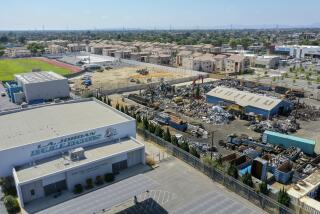Editorial: How to pay for cleaning up the Exide mess
The now-closed Exide battery recycling plant in Vernon has apparently spread toxic lead dust through a much larger area than had previously been believed, perhaps contaminating as many as 10,000 homes. That revelation by state officials this month means thousands of children may have been exposed to a dangerous neurotoxin that can cause learning disabilities and behavioral problems. Making the properties safe for residents could require the largest cleanup of its kind in California history.
Community activists and residents have long suspected that pollution from the Exide plant left a large stain of contamination on surrounding neighborhoods. Their fears were confirmed last year, when the California Department of Toxic Substances Control released the results of an initial round of sampling that found 39 houses in Boyle Heights and Maywood had levels of lead in the soil high enough that they should trigger health evaluations. Officials warned parents not to let their children play in the dirt at those houses. Soon after, the state ordered testing at 146 additional houses over a larger area and found lead (along with other metals associated with battery recycling) in properties up to 1.7 miles downwind of the plant. Based on computer modeling, the department estimated that 5,000 to 10,000 properties could be tainted by lead emissions and could require cleanup.
The immediate questions are: How quickly can the contaminated yards be cleaned up? Who should pay for it? And can the community trust state regulators to do a thorough and expeditious job?
The fact is, it was the DTSC that allowed Exide to operate with a temporary permit and outdated pollution controls for 30 years, despite repeated air-quality and hazardous-waste violations. The agency ignored or downplayed community concerns for years. In March, Exide agreed to shut down permanently its troubled plant rather than face federal criminal prosecution for environmental crimes. So there is an understandable skepticism in the neighborhood that the agency is willing or able to lead a proper cleanup of the contaminated homes.
Last week, Los Angeles County Supervisor Hilda Solis called on Gov. Jerry Brown to appoint an independent expert to oversee the soil cleanup and find money to start work as soon as possible. Whether an outsider is appointed or not, Solis and others worry that the DTSC will follow the standard enforcement model by ordering Exide to fund the full investigation and remediation; that could cause years of delay if Exide fights the order in court, which it would most likely do. The company denies that lead from the plant reached residential neighborhoods and says the contamination could have come from lead paint, leaded gasoline or other industrial operations in the area.
Although lax enforcement of environmental laws certainly played a part in this 30-year fiasco, Exide ultimately should be held responsible for the expense. The difficult part is making sure the inevitable lawsuits don’t slow the cleanup. To that end, the DTSC should begin its full investigation and remediation immediately. That will take a lot of money. The agency has overseen soil removal at nearly 150 homes so far, at a cost of roughly $40,000 each. If the project ultimately encompasses 5,000 to 10,000 houses, the total cost could be $200 million to $400 million — vastly more than the $9 million Exide has set aside. Agency Director Barbara Lee and state officials scraped together $7 million to begin the work, which is a start, but state leaders will have come up with much more money to expedite the effort.
Brown and the DTSC simply cannot allow this public risk to continue for much longer. By failing to properly regulate Exide, the state allowed this public health risk to grow. The state must do everything possible to make the community safe again.
Follow the Opinion section on Twitter @latimesopinion and Facebook
More to Read
A cure for the common opinion
Get thought-provoking perspectives with our weekly newsletter.
You may occasionally receive promotional content from the Los Angeles Times.










